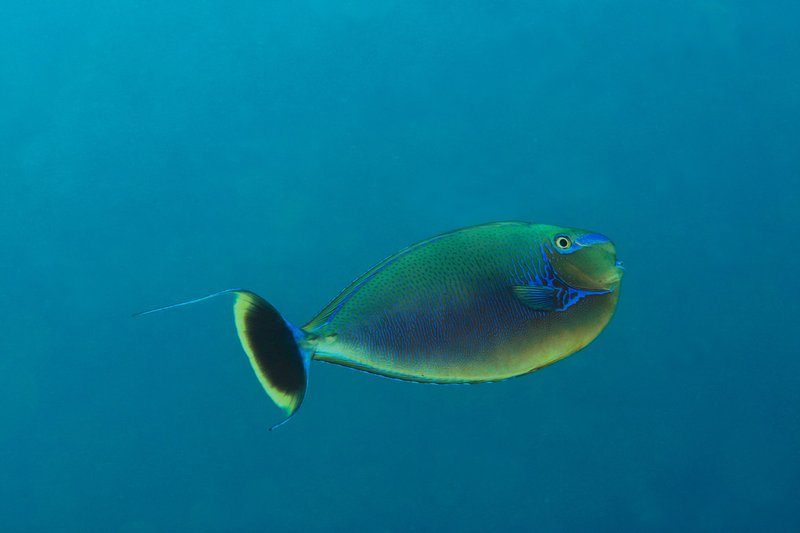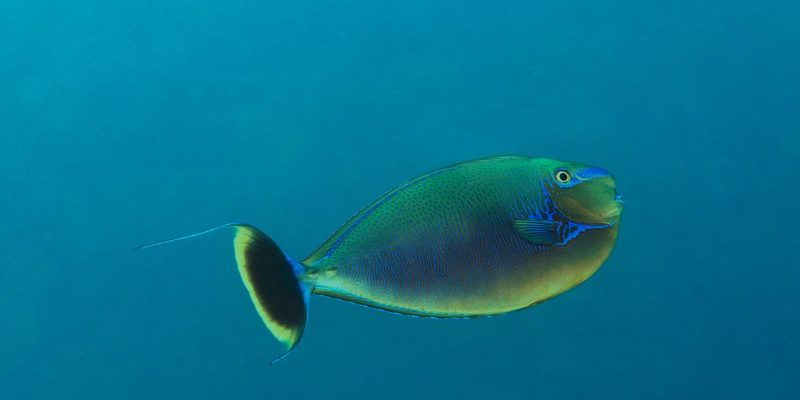
The Vlamingii Tang isn’t just a pretty face, though. This fish also has an interesting personality and can adapt well to tank life, given the right conditions. If you’re thinking about adding one to your underwater world, let’s dive into what makes this fish so unique, how to care for it, and what you can expect in terms of its behavior and habitat needs.
Physical Characteristics
The Vlamingii Tang is instantly recognizable thanks to its elongated body, which can reach lengths of up to 12 inches. With its striking colors, this fish may start out predominantly yellow but develops a beautiful gradient of blue as it matures. This transition can be like watching a sunset unfold, adding depth and beauty to your aquarium.
These fish also have prominent dorsal fins that can be raised or lowered, adding to their expressive nature. Their fins are not just for show; they play critical roles in navigation and communication. When observing a Vlamingii Tang, you might notice how it uses its fins to maneuver through coral reefs, twisting elegantly through the water as if it were dancing.
Another notable feature of the Vlamingii Tang is its distinctive mouth, which is designed for grazing on algae. This characteristic showcases its herbivorous diet and helps in maintaining the health of your tank by controlling algae growth.
Habitat and Range
The Vlamingii Tang thrives in the warm, shallow waters of the Indo-Pacific region, primarily residing around coral reefs and lagoons. Imagine a sun-drenched reef bustling with life—this fish fits right into that vibrant ecosystem. The coral formations provide not just shelter but also a rich source of food for these grazers.
In the wild, Vlamingii Tangs are often found in schools, swimming together for protection against predators. This social behavior is fascinating, as it highlights how important community is in their life. When you introduce a Vlamingii Tang into your aquarium, it’s worth considering the social dynamics—these fish tend to prefer company, so keeping them in groups can mimic their natural habitat and reduce stress.
Understanding their habitat needs is essential for any potential aquarist. A well-designed aquarium should have plenty of open swimming space, along with hiding spots, like rocks or plants, to make your Vlamingii Tang feel at home. This setup not only enhances their well-being but also makes for a captivating display.
Diet and Feeding Habits
Feeding a Vlamingii Tang can be a delightful experience, as these fish enjoy a varied diet. In their natural environment, they primarily graze on algae, supplemented by various plant materials. Think of it like a buffet of greens—you want to make sure your fish get a balanced diet to thrive!
In captivity, you can replicate this by offering high-quality herbivore flakes or pellets, along with leafy greens like nori (seaweed) or spinach. It’s like giving them a salad bar! You should aim to feed them several times a day in smaller portions. This prevents overfeeding and keeps their digestion in check—plus, it allows you to enjoy their lively feeding behavior.
You might be wondering: how do I know if they’re getting enough to eat? Look for signs of good health, such as vibrant colors and consistent swimming patterns. If your Vlamingii Tang is active and grazing throughout the day, you’re likely doing a great job with their diet!
Behavior and Compatibility
When it comes to behavior, the Vlamingii Tang is playful and curious. It exhibits a blend of social and territorial tendencies, which can lead to some fascinating interactions in your aquarium. They enjoy exploring their environment, often hovering near rocks or plants as they search for food.
However, keep in mind that these fish can become somewhat territorial, particularly as they establish their place within the tank. To avoid conflicts, you should introduce them into your aquarium carefully, ideally adding them last or ensuring they have enough space to roam. You might think of it like introducing a new friend into a tight-knit group; a little space can go a long way in fostering harmony!
In terms of compatibility, Vlamingii Tangs can get along well with many other reef fish, but avoid pairing them with overly aggressive species. Community tanks with a mix of peaceful fish will create a vibrant, dynamic environment that mirrors their natural social settings.
Aquarium Setup for Vlamingii Tang
Creating the ideal environment for your Vlamingii Tang is essential for its health and happiness. You’ll want a spacious aquarium—about 100 gallons is recommended for an adult fish—offering plenty of room to swim and explore. Think of this as giving them a vast ocean to roam, rather than a cramped apartment.
When setting up, incorporate a mix of live rock, which provides hiding spots and grazing opportunities, and sandy substrates that mimic their natural habitat. This arrangement not only looks beautiful but also promotes a healthy ecosystem within the tank, where beneficial bacteria can thrive.
Additionally, maintaining water quality is crucial. Vlamingii Tangs prefer clean, warm saltwater with stable parameters. Regular testing and water changes are vital to keep the environment safe. This commitment to their setup will pay off, as a well-maintained aquarium leads to a happy, healthy fish.
Breeding and Reproduction
Breeding Vlamingii Tangs in captivity can be quite challenging. While these fish can spawn in the right conditions, they require specific environmental triggers, such as temperature fluctuations and increased light. Without these factors, breeding efforts may end up being fruitless, similar to trying to grow flowers in the wrong season.
In the wild, Vlamingii Tangs partake in a spectacular spawning ritual, where males display their vibrant colors to attract females. If you’re lucky enough to set up a breeding pair, you may witness this beautiful spectacle. Just remember that breeding requires advanced knowledge and a meticulously maintained tank.
If you’re not ready to dive into breeding, no worries! Most aquarists enjoy keeping Vlamingii Tangs simply for their beauty and personality. A single fish can bring quite a bit of joy and color to your tank without the added challenges of raising fry.
Health and Common Issues
Like any fish, Vlamingii Tangs can occasionally face health issues. Common problems include ich, a parasitic infection that manifests as white spots on the skin, and fin rot, which can occur due to poor water quality. Keeping an eye on your fish and their behavior can help catch these issues early.
To prevent health problems, it’s essential to monitor their environment regularly. Maintaining clean water and a balanced diet plays a key role. If you suspect your Vlamingii Tang is sick, proper quarantine procedures are crucial. This helps prevent the spread of diseases to other tank mates.
Regular vet check-ups or consulting an aquatic veterinarian can also be beneficial if you notice any concerning behavior. Being proactive about your fish’s health is like going for regular check-ups—it’s all about keeping them happy and thriving!
Conservation Status
In terms of conservation, the Vlamingii Tang is currently classified as “Least Concern” on the IUCN Red List. However, as with many marine species, they face threats from habitat loss and overfishing. The importance of sustainable practices in aquaculture is vital for ensuring that these beautiful fish continue to thrive in the wild.
By choosing to source your Vlamingii Tang from reputable breeders or stores that prioritize sustainability, you can help support the preservation of these stunning creatures. It’s a small step towards making a big difference in marine conservation efforts.
The Vlamingii Tang isn’t just an attractive addition to your aquarium; it’s a lively, interesting fish that can bring joy and color to your underwater world. With the right care, a well-maintained environment, and a commitment to understanding their needs, these fish can thrive in your home.
So, whether you’re a seasoned aquarist or just starting your journey, adding a Vlamingii Tang might be one of the best decisions you make for your aquarium. Watching these beautiful fish glide gracefully through the water is an experience like no other—almost enchanting, right?
FAQ
What size tank do I need for a Vlamingii Tang?
Vlamingii Tangs require a minimum tank size of 100 gallons, as they need ample swimming space and hiding spots. A larger tank allows for a healthier environment, reducing territorial disputes and stress among tank inhabitants.
Can Vlamingii Tangs live with other fish?
Yes, Vlamingii Tangs can coexist with many species of reef fish. However, be cautious with aggressive species, as they might not get along. Keeping them with peaceful tank mates will create a more harmonious environment.
What do Vlamingii Tangs eat in captivity?
In captivity, Vlamingii Tangs enjoy a diet that includes high-quality herbivore pellets, flakes, and fresh greens like nori and spinach. A varied diet helps maintain their health and vibrant colors.
How can I tell if my Vlamingii Tang is healthy?
A healthy Vlamingii Tang will have bright colors, be active, and exhibit normal swimming behavior. If you notice changes such as loss of color, lethargy, or unusual swimming patterns, it might be time to check water quality or consult a veterinarian.
How often should I feed my Vlamingii Tang?
Feed your Vlamingii Tang several small portions throughout the day. This mimics their natural grazing behavior and helps prevent overeating or digestive issues.
What are common illnesses that affect Vlamingii Tangs?
Vlamingii Tangs can be susceptible to diseases like ich and fin rot, often caused by poor water quality or stress. Regular water testing and maintaining a clean environment can help prevent these issues.
Can I breed Vlamingii Tangs in captivity?
Breeding Vlamingii Tangs can be quite challenging and requires specific conditions. While they can spawn in captivity, it generally requires advanced knowledge and a carefully controlled environment.
Are Vlamingii Tangs suitable for beginner aquarists?
While Vlamingii Tangs are beautiful and relatively easy to care for, they do require a larger tank and specific water conditions. Beginners should be prepared to invest time and effort into maintaining their environment for the best results.
What is the lifespan of a Vlamingii Tang?
In a well-maintained aquarium, Vlamingii Tangs can live up to 5 to 7 years or more. Providing proper care, a balanced diet, and a healthy environment are key factors in maximizing their lifespan.
Do Vlamingii Tangs change colors as they grow?
Yes, Vlamingii Tangs often change colors as they mature. They typically start as bright yellow and develop blue hues as they grow, making them even more visually stunning.
How can I reduce aggression in my Vlamingii Tang?
To reduce aggression, ensure your aquarium has plenty of hiding spots and ample swimming space. Introducing new fish gradually and keeping a peaceful community can also help promote harmony among tank mates.

